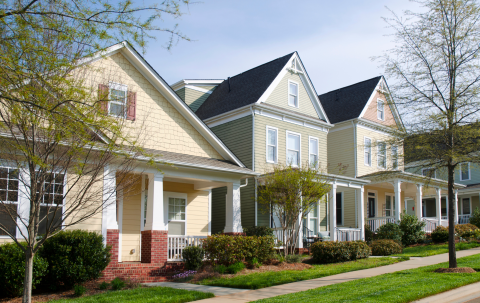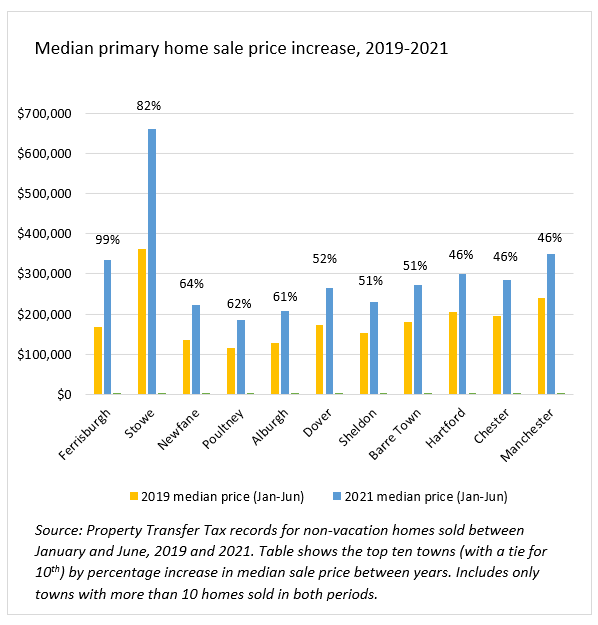
The median Vermont primary home sold for $259,900 during the first six months of 2021, compared to $245,000 throughout 2020, a six percent increase. This aligns with the 6.9% price increase seen between 2019 and 2020, suggesting that the state is on track for significant but steady growth in home sale prices.
However, some areas of the state saw much larger price growth over the course of the pandemic. As shown in the graph, some towns saw nearly doubled home prices between 2019 and 2021 (January through June sales). These towns were scattered across Vermont, although most in the southern half of the state. Notably, none of those towns were in Chittenden County, which has historically had the highest home prices and the largest population growth in the state.
Several of the towns with the greatest home price increases are in rural areas that experienced unusually high population growth recorded during the 2020 Census, potentially from out of state buyers fleeing from the pandemic. However, price increases in other areas like Ferrisburgh and Barre Town might be reflecting demand from buyers who are looking for homes near job centers but have looked further away than usual due to limited options.
There were 3,948 homes sold statewide between January and June of 2021, compared to 3,379 during the same period in 2019, prior to the pandemic. However, despite that substantial increase, the Vermont market still lacks enough homes to meet demand. Inventory in July 2021 was 31 percent lower than same period of the prior year, according to data from Redfin. Lack of inventory has led to faster home sales, with the median days on market dropping to 69 days in July, compared to 78 days in July of 2020. Increased competition and faster home sales tend to increase sale prices.
It remains difficult to predict how quickly prices will continue to increase over the coming months. The median price of a primary home sold in June 2021 was $285,520, compared to $245,000 in June of 2020, a 17 percent price increase. However, the home sale market is seasonal, and in normal years tends to slow down slightly after the end of the summer. The six percent increase between 2020 through the first six months of 2021 is much more in line with the year to year increase that had been seen before the pandemic.
Many national real estate experts anticipate that the market will cool slightly this fall and into 2022, with inventory increasing and the strong impetus to move that characterized the early stages of the pandemic waning. While Vermont home prices are unlikely to actually decline, a return to a more normal home sale market may mean a slower growth in prices.
In many respects, the narrative that Vermont is experiencing an out-of-control housing market overlooks the fact that the state has faced an affordability crisis for years. Vermont’s long-standing lack of homes affordable to moderate-income households has more to do with a persistent decline in homebuilding over the last several decades than out of state migrants.
However, VHFA programs may be able to help first-time buyers get their foot in the door. VHFA recently expanded its Down Payment Assistance Program to offer up to $10,000 for down payment and closing costs for qualified borrowers. Income and other eligibility requirements apply. All VHFA programs are offered through local participating lenders. Go to www.vhfa.org/homebuyers to learn more.


